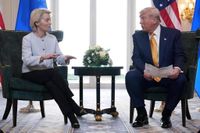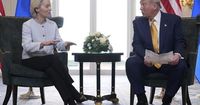On August 21, 2025, American and European Union officials unveiled what they called a "first step" in reworking one of the world’s most significant trading relationships. The new trade deal, announced with much fanfare but little fine print, imposes a 15% import tariff on 70% of European goods shipped to the United States—a dramatic shift from previous years, and one that has set off a flurry of reactions on both sides of the Atlantic.
The announcement, made jointly by U.S. President Donald Trump’s administration and the European Commission led by Ursula von der Leyen, came after weeks of tense negotiations. The two leaders met at the Trump Turnberry golf course in Scotland on July 27, 2025, to hammer out the broad outlines of the agreement. But as Associated Press and Investment Executive both reported, the resulting document was just 3 1/2 pages long—a far cry from the sprawling, legally binding texts that typically define trade policy. Instead, it represents a political commitment, not a legal one, and leaves many crucial details to be worked out in future talks.
The core of the deal is straightforward, at least on paper. A 15% tariff now applies to the majority of European goods entering the U.S., replacing the patchwork of lower tariffs that existed before President Trump’s aggressive tariff policies. In exchange, the EU agreed to open its $20 trillion market—the second largest in the world—to more American products. Some sectors, however, won key exceptions: aircraft and aircraft parts, along with generic pharmaceuticals and pharmaceutical ingredients, are exempt from the 15% rate. Other industries, like wine and spirits and steel, were notably left out of the agreement, with both sides promising to revisit those issues.
For American exporters, the most eye-catching provision is the elimination of tariffs on U.S. cars and other industrial goods sold to the European Union’s 27 member states. This zero-tariff rate marks a significant win for American automakers, who had been facing stiff barriers in the lucrative European market. Howard Lutnick, Trump’s commerce secretary, didn’t mince words on X (formerly Twitter): “The EU has agreed to open its $20 Trillion market. The second largest in the world behind the great USA. This deal is a major win for American workers, US industries, and our national security. Tariffs should be one of America’s favorite words.”
Yet the deal’s reception in Europe has been far more complicated. The European Automobile Manufacturers’ Association (ACEA), which represents 16 of the continent’s major car, van, truck, and bus makers—including BMW, Volkswagen, and Renault—welcomed the clarity provided by the joint statement, especially regarding U.S. auto tariffs. “This confirmation is a positive step that provides greater certainty for our industry,” said Sigrid de Vries, ACEA’s Director General. She emphasized that “it is now crucial that the Commission proceeds to implement the EU’s commitments without delay, mitigating the tariff impact which already has cost automakers millions of euros in duties every day.”
For the European automotive sector, which employs 13.2 million people and makes up 10.3% of all manufacturing jobs in the EU, the reduction of U.S. tariffs on EU automobiles—from a punishing 27.5% down to 15%—is a relief. The industry generates €383.7 billion in tax revenue and posts a €106.7 billion annual trade surplus, according to ACEA. With over 7.5% of the EU’s GDP tied to auto manufacturing and €72.8 billion spent each year on research and development, the stakes are enormous.
Still, the deal is far from comprehensive. As AP and Investment Executive highlighted, entire sectors were left out of the initial agreement. Wine and spirits, for instance, had enjoyed zero tariffs since a 1997 trade deal, but are now subject once again to uncertainty. Maros Sefcovic, the EU’s chief trade negotiator, admitted that an exemption for these goods had not been won “yet,” but added that “doors are not closed forever” on the issue. The EU has suspended retaliatory tariffs on U.S. goods, including wine and spirits, until February 5, 2026, but the threat of renewed trade friction still hangs in the air.
Chris Swonger, president and CEO of the Distilled Spirits Council of the United States, voiced concerns about the lack of a permanent solution. “Without a permanent return to zero-for-zero tariffs on spirits, American distillers do not have the certainty to plan for future export and job growth without the fear of retaliatory tariffs returning,” he said in a statement quoted by AP.
Steel, another major transatlantic trade issue, was also left unresolved. Proposals to exempt a certain amount of EU steel imports, known as a tariff rate quota, remain on the table for future negotiations. For now, the 15% tariff stands—a significant hike from the low single-digit rates that prevailed before Trump’s tariff onslaught began.
Economists, meanwhile, have sounded the alarm about the broader impact of higher tariffs. As noted in AP coverage, increased import taxes tend to slow economic growth and drive up consumer prices. In the U.S., the costs of tariffs are typically absorbed by importing businesses or passed along to consumers at the cash register. European officials, including Commission President Ursula von der Leyen, have had to defend the deal against criticism from businesses and member governments who worry that the EU conceded too much. Von der Leyen, however, insisted that the agreement was necessary to avoid even more damaging trade conflict. “Faced with a challenging situation, we have delivered for our member states and industry and restored clarity and coherence to transatlantic trade,” she said. “This is not the end of the process.”
Maros Sefcovic echoed her view, stating, “The alternative was a trade war with sky-high tariffs ... it builds confidence. It brings stability.” The deal also contains nonbinding EU commitments to purchase $750 billion in U.S. energy and for EU companies to invest $600 billion in the U.S.—figures based on private sector plans assessed by the European Commission, not government mandates.
For all its significance, the agreement remains a work in progress. The document’s brevity and lack of legal force have left many details to be hammered out in what both sides describe as an ongoing process. The lower tariff on cars, for instance, will only apply retroactively from August 1, 2025, if the EU can pass the necessary legislation in time—a detail officials say they are committed to meeting.
As the dust settles, the world’s largest bilateral trading relationship finds itself in a period of transition. The deal marks a move away from escalating tariffs and toward a more stable, predictable framework for transatlantic commerce. But with so many issues left unresolved, the coming months will be critical as negotiators try to turn this political handshake into a robust, lasting agreement.
For now, businesses, consumers, and policymakers on both sides of the Atlantic are left watching and waiting—hoping that future rounds of talks will bring the clarity and certainty that this historic, if incomplete, deal has yet to deliver.


